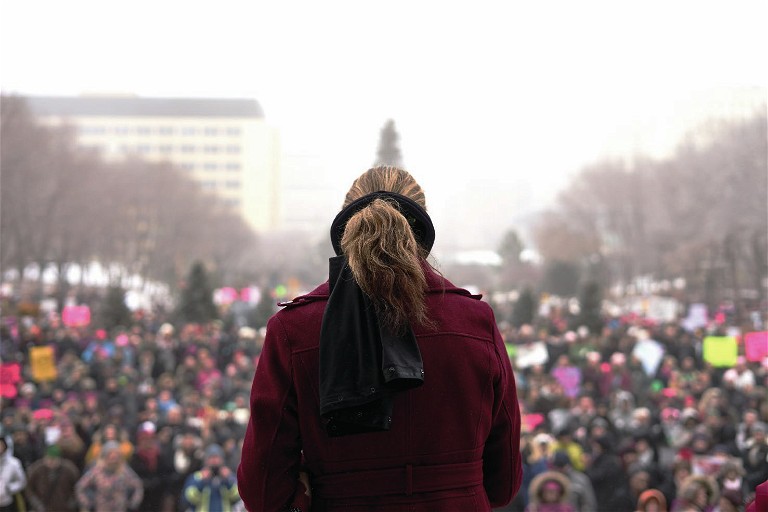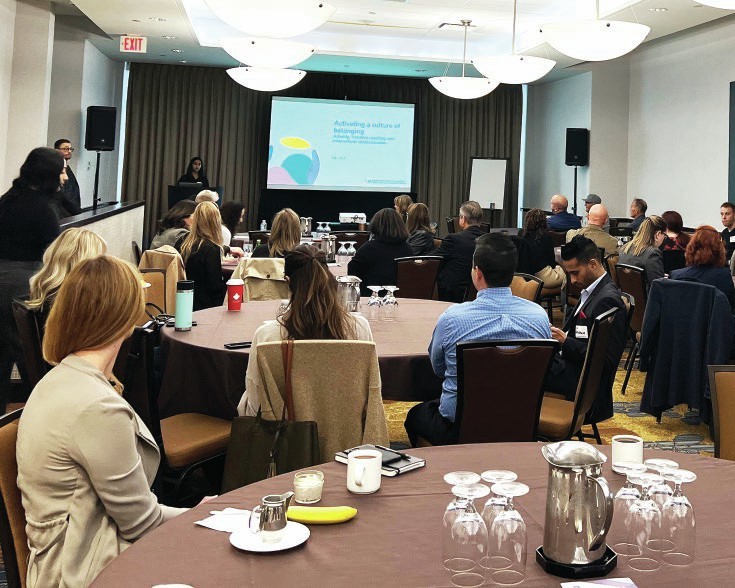Moving the Needle
CCDI’s CEO on the past, present and future of DEI
By Bryan Hansen

Marni Panas, Director and Chair of CCDI’s board, participating in an International Women’s Day event in Edmonton.
The Canadian Centre for Diversity and Inclusion (CCDI) is a social organization that strives to help workplaces become inclusive, free of prejudice and discrimination and help people recognize diversity as an asset rather than an obstacle. To achieve these goals, CCDI employs research-based reports, toolkits and their annual Unconference – an immersive, interactive and collaborative event for those interested in diversity, equity and inclusion (DEI). Anne-Marie Pham, CCDI’s CEO, has been associated with the organization for over a decade, initially leading DEI for the City of Calgary before becoming one of CCDI’s founding employing partners. Over time, the organization has expanded to offer direct consulting to clients, manage partner relations and provide top learning and leading solutions.
Pham’s background experience, grounded in community work with immigrants, youth and women, helped her foster CCDI’s vision. “I’ve always been committed to the vision of CCDI,” she says. “It was a vision I had before I was CEO. Wouldn’t it be great if we had an organization in Canada that would support workplaces to be more diverse, inclusive and equitable?”
CCDI provides a national body to understand trends when it comes to DEI in the workplace, and to help employers walk with them on that journey. “What I like about CCDI is the ability to support all dimensions of diversity,” Pham explains. “The vision of CCDI is all-encompassing and inclusive. I love helping others reach their full potential, and it was a natural fit for me to be part of this organization.”
In the last 10 years, Pham says there has been noticeable improvement on DEI in Canadian workplaces. “Like any movement towards social change, there are ebbs and flows and ups and downs. I think that for DEI policy, there was increased awareness and understanding of the need to have inclusive DEI policies,” Pham says. “The bigger corporations and more established organizations often allocated a budget and people to review their policies and practices. [This] is one of the leading practices – [to] create inclusivity at a systemic level. [With] public companies that must report to stakeholders and shareholders, we are seeing that increased accountability.” That increased accountability, however, “depends on the leader of an organization and whether that person continues to be committed to doing the work,” explains Pham. “A policy doesn’t exist forever, so if you have a new person come in to lead, they could reverse policy.”
The existence of a policy is not something to be taken for granted. “We need to review [policies] on a regular basis for the organization/workforce, and it’s important to work with employers to continue to raise awareness of a systemic review of all elements in a workplace to become more diverse, equitable and inclusive.”
To keep policies relevant, Pham states that regular reviews and relevant training are essential pieces, as well as ensuring that “training is followed up by learning conversations which, in turn, lead to action. Individuals need to know the role they have to play in making workplaces more equitable.”
While policies are one part of the DEI equation, dialogue and moving the needle is another integral aspect. “Everyone has a role to play. You can make more inclusive team meetings, inclusive language and create safe and courageous places to have conversations where folks have authentic questions and can be their authentic selves. It’s important to ask questions and be able to learn together,” states Pham. “A policy is a piece of paper. Inclusivity is living that practice and making it happen.”
When it comes to the future of DEI, Pham says, “We have a long way to go.” The next 10 years will bring its own set of challenges and new issues to the forefront. One current example is artificial intelligence (AI) and how it impacts workplace dynamics. “We’ve already seen division in recent years with AI in social media posts, and how this has partly caused increased polarization in our society,” explains Pham. “AI is a topic of the future that we need to start addressing today.”
Along with AI, Pham lists several other topics that need continued dialogue for a more inclusive future, some of which are coming from the past. “The #MeToo movement – we still see issues of gender equity and sexual assault in the workplace,” says Pham. “Our 94 Calls to Action – we have a significant lack of progress on Indigenous Truth and Reconciliation.”
These legacy issues will be accompanied by newly emerging scenarios. “We are going to accept growth of 500,000 newcomers to Canada every year,” states Pham. “What are we doing to reduce barriers for [work] experience? Inclusivity? What are we doing to modernize the workplace to welcome a young generation of workers?”
To help employers combat newly emerging division and hate rhetoric, CCDI will be holding events on depolarizing the workplace. “It is one of the more pressing issues in our society today,” Pham explains. “Our world is [becoming] increasingly more polarized, more divisive, and each of us needs to learn how to go into these conversations with humility and vulnerability.” This then opens a line for listening and understanding what others are trying to say, and engaging with respectful dialogue instead of “going in prepared for a debate with a win/lose, right/wrong situation. If opposing parties can come to the table with an agreement [that] they are working together to deal with the problem, as opposed to being the problem themselves, it will shift the paradigm for deeper dialogue to solve the problem.”

CCDI staff during the development of one of their Community of Practice Events (COPE) in Calgary.
Pham says that approaching conversations with this mindset is not easy to do when we are used to thinking and working in a particular way. “We need to work with [others] so we can try to work together, creating a work environment that works for all, not just some. This requires effort at both ends.”
“There is a lot of misinformation out there,” she concludes, but adds reassuringly that “the vast majority of our colleagues and clients are good people.” ■